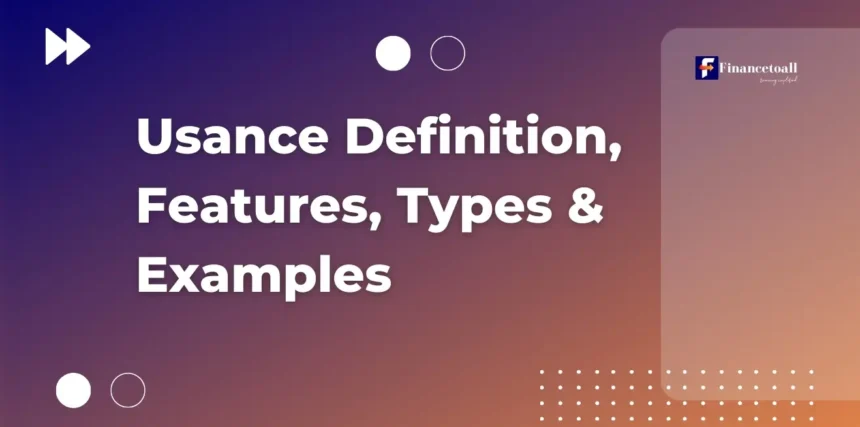Understanding Usance in Finance: A Complete Guide
Usance refers to the credit period granted to a buyer to settle payment for goods or services after the shipment or delivery date. It is commonly used in trade finance through instruments like letters of credit or bills of exchange, providing flexibility for buyers to arrange funds and manage cash flow effectively.
When it comes to trade finance, one term that often comes up is usance. If you’re involved in importing, exporting, or managing credit terms in any way, understanding usance can help you make better financial decisions and improve your cash flow. In this article, we will understand what usance means, how it works, and why it’s so important in global trade.
Key Takeaways About Usance
- Usance Enables Deferred Payments: Usance is a credit period granted to buyers, allowing them to defer payments to sellers for an agreed period, typically ranging from 30 to 180 days.
- Widely Used in Trade Finance: Usance is commonly utilized in instruments like letters of credit and bills of exchange, making it a vital tool for facilitating international and domestic trade.
- Benefits Both Buyers and Sellers: Buyers gain time to generate revenue or manage cash flow, while sellers attract more business by offering flexible payment terms, often backed by bank guarantees.
- Banks Play a Crucial Role: Financial institutions act as intermediaries, providing assurance to sellers and credit to buyers, often earning fees or interest for facilitating usance transactions.
- Risks Must Be Managed Carefully: While usance offers numerous advantages, risks like buyer defaults, currency fluctuations, and interest costs need to be addressed through clear agreements and proper documentation.
What is Usance?
Usance refers to the time allowed for a buyer to settle a payment owed to a seller under an agreed-upon financial arrangement. In simpler terms, it’s the credit period a seller offers to a buyer, usually outlined in trade finance instruments like letters of credit (LCs) or bills of exchange.
Example of Usance in Action
Imagine you’re a clothing retailer who buys inventory from a supplier. Instead of paying the supplier immediately, the supplier allows you 60 days to pay. This 60-day period is known as the usance period.
Why is Usance Important?
Usance plays a key role in trade finance because it gives buyers the flexibility to sell goods or generate cash flow before making payments. At the same time, it ensures sellers get a clear timeline for receiving payments, often backed by banks or financial institutions.
Key Benefits of Usance
- For Buyers:
- Helps manage cash flow by delaying payments.
- Offers time to generate revenue from goods before paying suppliers.
- For Sellers:
- Encourages trade by offering flexible payment terms.
- Can secure payment guarantees through banks.
- For Banks:
- Banks involved in usance transactions earn fees or interest, making it a lucrative offering.
Usance vs. Sight Terms: What’s the Difference?
When we talk about trade finance, another term often mentioned is sight terms. Let’s compare the two:
| Feature | Usance Terms | Sight Terms |
|---|---|---|
| Payment Timing | Deferred payment after a set period. | Immediate payment upon sight. |
| Buyer’s Advantage | Offers time to arrange funds. | Requires immediate cash. |
| Seller’s Advantage | May charge interest for longer credit. | Immediate liquidity. |
Example:
If a seller ships goods with a sight letter of credit, the buyer pays as soon as the goods are delivered. With a usance letter of credit, the buyer might get 30, 60, or 90 days to pay.
How Usance Works in Letters of Credit
A usance letter of credit is a popular tool in international trade. Here’s how it works:
- Agreement: A buyer and seller agree on usance terms, such as payment after 90 days.
- Issuance of LC: The buyer’s bank issues a usance letter of credit, guaranteeing payment after the usance period.
- Shipment of Goods: The seller ships goods and submits shipping documents to the bank.
- Payment Timeline: The buyer has the agreed-upon time (e.g., 90 days) to make the payment. The seller is assured of payment since the bank backs the LC.
Usance in Bills of Exchange
A bill of exchange is another financial instrument where usance is commonly used. It’s like a written promise between a seller (drawer) and a buyer (drawee). The usance period gives the buyer time to pay after accepting the bill.
Example:
A textile manufacturer in India sells fabric to a retailer in Germany. The manufacturer sends a 60-day usance bill of exchange. The retailer accepts the bill, agreeing to pay within 60 days of receipt.
Key Features of Usance
- Time-Based: Usance is all about time. The duration could be as short as 30 days or as long as 180 days, depending on the agreement.
- Structured Payment: It ensures buyers and sellers have clear payment timelines, reducing misunderstandings.
- Bank Involvement: Banks often act as intermediaries, providing assurance to sellers and credit to buyers.
- Interest or Fees: For longer usance periods, sellers may charge interest or discount the payment amount.
Benefits of Usance in Trade Finance
Usance simplifies global trade. Here’s how:
For Businesses
- Improves Cash Flow: Buyers can manage liquidity better by deferring payments.
- Encourages Trade: Sellers are more likely to close deals by offering flexible payment terms.
- Supports Growth: With more time to pay, businesses can scale operations without immediate financial strain.
For Banks
- Revenue Streams: Banks earn fees or interest by financing the usance period.
- Risk Mitigation: By guaranteeing payments under LCs, banks reduce the risk of non-payment.
Risks Associated with Usance
While usance offers many benefits, it’s not without risks. Let’s look at some:
- Buyer’s Default: There’s always a risk that the buyer won’t pay within the usance period.
- Currency Fluctuation: In international trade, exchange rate changes during the usance period can affect payment amounts.
- Interest Costs: Sellers may charge buyers higher prices or interest for longer usance periods.
- Documentation Errors: Misunderstandings about the usance terms can lead to disputes.
Real-Life Examples of Usance in Trade
Domestic Trade Example
A furniture manufacturer in the U.S. sells $100,000 worth of furniture to a retailer under a 90-day usance agreement. The retailer has three months to sell the furniture and generate enough revenue to pay the manufacturer.
International Trade Example
An exporter in China ships electronics to an importer in Africa under a 60-day usance letter of credit. The importer has 60 days to sell the electronics and pay the exporter.
How to Negotiate Usance Terms
If you’re a buyer or seller, negotiating the right usance terms is crucial. Here are some tips:
- Understand Your Needs: Buyers should ensure the usance period aligns with their cash flow cycles.
- Be Transparent: Sellers should clearly communicate any fees or interest associated with usance.
- Involve Banks: Using financial institutions ensures smoother transactions and reduces risks.
- Leverage Technology: Tools like trade finance platforms can simplify negotiations and documentation.
What Happens if a Buyer Fails to Pay During the Usance Period?
If a buyer fails to pay, the seller can claim payment from the issuing bank (in the case of a letter of credit) or seek legal action to recover dues. Trade credit insurance can also help mitigate losses.
Using Usance to Boost Trade Relationships
Offering or requesting usance terms isn’t just about delaying payment; it’s a strategic tool to strengthen partnerships. Sellers offering flexible credit terms often secure repeat business, while buyers gain trust by honoring payments within the agreed timeline.
Conclusion
Usance is a cornerstone of trade finance, providing flexibility, security, and growth opportunities for businesses and financial institutions. Whether it’s through a usance letter of credit or a bill of exchange, these deferred payment terms help simplify global trade.
Frequently Asked Questions (FAQ) About Usance
1. What is Usance in finance?
Usance refers to the time allowed for a buyer to make payment to a seller under a trade finance agreement, such as a letter of credit or a bill of exchange. It’s essentially the credit period given to the buyer.
2. How does Usance differ from Sight terms?
Usance Terms: Payment is deferred and made after a specified period (e.g., 30, 60, or 90 days).
Sight Terms: Payment is made immediately upon presentation of the required documents.
3. What is a Usance Letter of Credit?
A usance letter of credit (LC) is a trade finance instrument where the buyer is allowed to make payment after a specified credit period. The issuing bank guarantees payment to the seller after the usance period expires.
4. Who benefits from Usance terms?
Both buyers and sellers benefit:
Buyers: Gain time to arrange funds or sell goods before making payment.
Sellers: Attract more buyers by offering flexible payment terms and get payment assurance from banks if using an LC.
5. What is the typical Usance period?
The usance period can vary based on the agreement but usually ranges from 30 to 180 days. For international trade, it often aligns with the time required for the buyer to sell the goods and collect revenue.
6. What are the risks associated with Usance?
Buyer default or delayed payments.
Currency fluctuations in international trade.
Interest or additional fees for extended credit periods.
Documentation errors leading to disputes.
7. Can Usance terms be negotiated?
Yes, the usance period and associated terms can be negotiated between the buyer, seller, and banks to align with both parties’ financial and operational needs.
8. How do banks facilitate Usance payments?
Banks act as intermediaries, providing assurance to sellers through instruments like letters of credit. They also finance buyers during the usance period, charging interest or fees for their services.
9. Is Usance suitable for small businesses?
Yes, usance is especially beneficial for small businesses as it helps manage cash flow, reduce upfront financial strain, and allows time for sales revenue to cover payments.
10. How can a seller mitigate the risks of Usance?
Use a bank-guaranteed usance letter of credit for secure payment.
Vet buyers for creditworthiness before extending credit terms.
Clearly outline usance terms in the trade agreement to avoid disputes.












